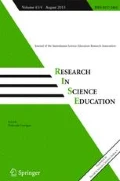Conclusion
Making sense of the world-including the world of school learning-involves making connections between new and existing experiences. Whether this process is called the construction (Piaget, 1929), the generation (Osborne & Wittrock, 1985) or the creation of meaning, the relation of new experiences to existing understandings, images, experiences, and feelings are essential to the process of learning with understanding.
For many years cognitive psychology has focused on the making of logical, sequential, highly structured connections. However, the computer metaphor for human information processing and storage is now being questioned and cognitive psychologists are beginning to explore the new ‘unexplorable’-parallel, holistic, divergent, creative mental processes.
In addition, this paper proposes a model of the learning process in terms of reciprocally interactive cognitive, affective, and social variables.
Similar content being viewed by others
References
AUSUBEL, D.P. (1968)Educational psychology: a cognitive view. New York, Holt, Rinehart & Winston.
BANDURA, A. (1977a)Social learning theory. Englewood Cliffs, Prentice-Hall.
BANDURA, A. (1977b) Self-efficacy: toward a unifying theory of behavioral change.Psychological Review, 84, 191–215.
BECK, A.T. (1976)Cognitive therapy and the emotional disorders. New York, International Universities Press.
BROWN, G.I. (1971)Human teaching for human learning. New York, The Viking Press.
BROWN, G.I. (ed.) (1975)The living classroom: innovation through confluent education and Gestalt. New York, The Viking Press.
BRUNER, J.S. (1966)Toward a theory of instruction. Cambridge, Mass., Harvard University Press.
BURNS, D.D. (1980)Feeling good: the new mood therapy. New York, William Morrow and Company.
CARELLO, C., TURVEY, M.T., KUGLER, P.N., & SHAW, R.E. (1984) Inadequacies of the computer metaphor. In M.S. Gazzaniga (ed.)Handbook of cognitive neuroscience. New York, Plenum Press.
DEWEY, J. (1933)How we think: a restatement of the relation of thinking to the education process. Boston, D.C. Heath and Company.
ELLIS, A. (1962)Reason and emotion in psychotherapy. New York, Lyle Stuart.
GAGNE, R.M. (1965)The conditions of learning. New York, Holt, Rinehart & Winston.
GHISELIN, B. (1955)The creative process. New York, Mentor Books.
HADAMARD, J.S. (1954)The psychology of invention in the mathematical field. New York, Dover Publications.
HODSON, D. (1985) Philosophy of science, science and science education.Studies in Science Education, 12, 25–57.
HUNT, M. (1982)The universe within. New York, Simon & Schuster.
KAHA, C.W. (1983) The creative mind: form and process.Journal of Creative Behavior, 17(2), 84–94.
KOESTLER, A. (1964)The act of creation. New York, Macmillan.
MASSIALAS, B.G. & ZEVIN, J. (1983)Teaching creatively: learning through discovery. Malabar, Robert E. Krieger Publishing Company.
NEWMAN, J.R. (ed.) (1956)The world of mathematics. New York, Simon and Schuster.
NODDINGS, N. & SHORE, P.J. (1984)Awakening the inner eye: intuition in education. New York, Teachers College Press.
NOVAK, J.D. (1977)A theory of education. Ithaca, Cornell University Press.
OSBORNE, R. & WITTROCK, M. (1985) The generative learning model and its implications for science education.Studies in Science Education, 12, 59–87.
OWENS, J., BOWER, G.H., & BLACK, J.B. (1979) The ‘soap opera’ effect in story recall.Memory and Cognition, 7, 185–91.
PHILLIPS, D.C. (1983) On describing a student's cognitive structure.Educational Psychologist, 18(2), 59–74.
PIAGET, J. (1929)The child's conception of the world. London, Paladin.
PIAGET, J. (1964) Cognitive development in children: development and learning.Journal of Research in Science Teaching, 2, 176–86.
POSNER, G.J., STRIKE, K.A., HEWSON, P.W. & GERTZOG, W.A. (1982) Accom modation of a scientific conception: toward a theory of conceptual change.Science Education, 66(2), 211–27.
RICHARDSON, A. (1984)The experiential dimension of psychology. St. Lucia, University of Queensland Press.
ROGERS, C.R. (1969)Freedom to learn. Columbus, Ohio, Charles E. Merrill Publishing Company.
SHUELL, T.J. (1985) Knowledge representation, cognitive structure, and school learning: a historical perspective. In L.H.T. West & A.L. Pines (eds).Cognitive structure and conceptual change. New York, Academic Press.
WILLIAMS, L.V. (1983)Teaching for the two-sided mind. Englewood Cliffs, N.J., Prentice-Hall.
Rights and permissions
About this article
Cite this article
Garrard, J. Creative learning in science education. Research in Science Education 16, 1–10 (1986). https://doi.org/10.1007/BF02356812
Issue Date:
DOI: https://doi.org/10.1007/BF02356812




